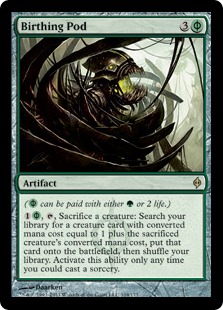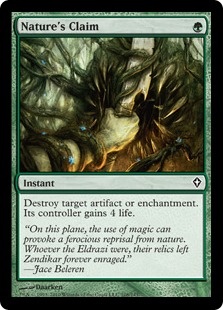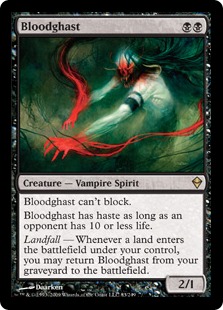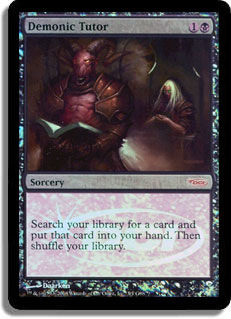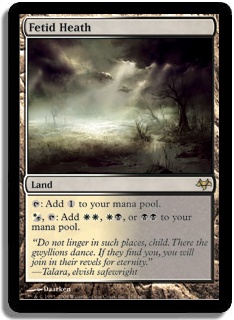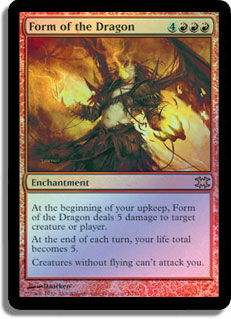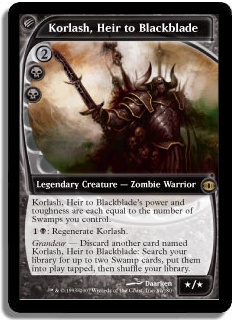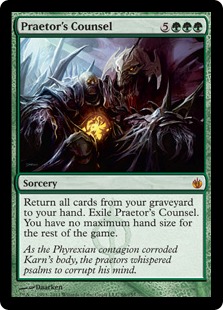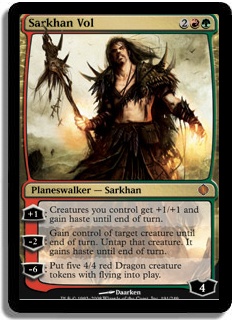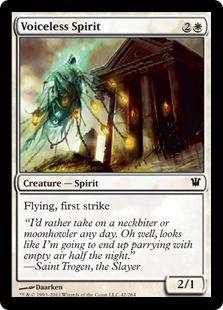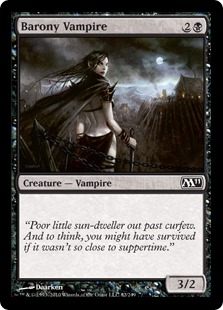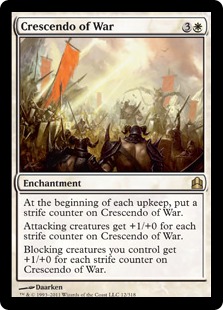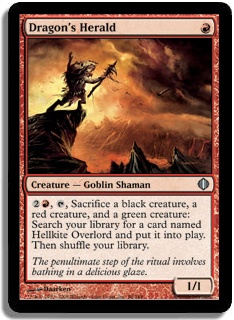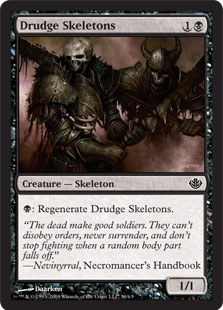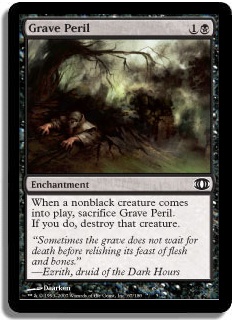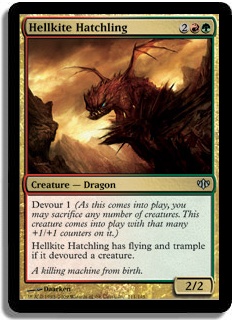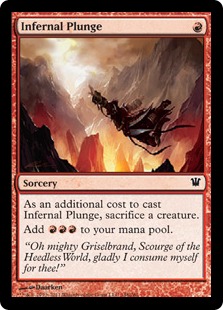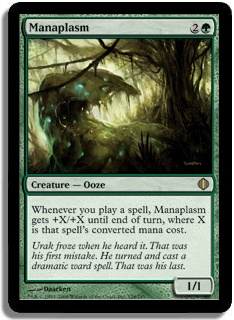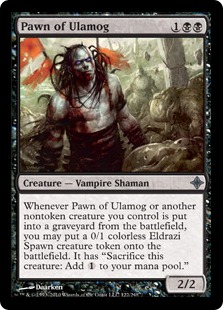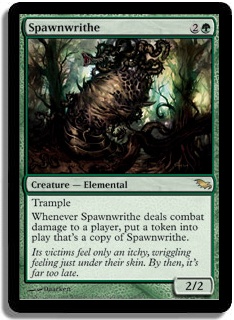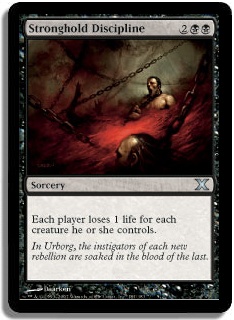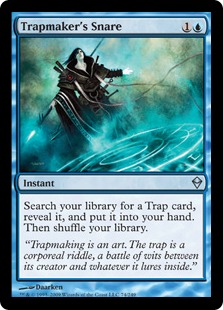As this goes up on the StarCityGames.com homepage, it is almost three years to the day that I met Daarken for the first (and so far only) time. The place was Grand Prix: Kansas City, the time October 2008. He was wearing a black 8-bit T-shirt and a lip ring. I was wearing a dress shirt and tie. I bought a Fetid Heath print and a Manaplasm artist’s proof, and I walked away with the feeling that he had more creative talent in one of his jet-black hairs than I could ever accumulate in a lifetime.
Players attending the StarCityGames.com Open Weekend in Las Vegas on the weekend of November 5 will get a chance to bask in the awesomeness of Daarken, get cards signed, buy swag, ask him about the experience of being a concept artist for Innistrad, and buy more swag.
I’ve been in contact with Daarken, and he wanted to share a couple of things with players looking to get cards signed:
1. Limit of twenty cards total per player, with a maximum of four for any individual card. We’ve all seen “that guy” with a towering stack of cards that he wants to get signed, including a suspiciously large number of rares and mythics, and the next day, they’re all on eBay. Daarken used to not have a limit, but the “flippers” have become so brazen, even telling him that the cards he was signing were to be sold, that he had to put restrictions in place. As Daarken himself put it, “I’m not here to make money for other people; I am here to sign cards, create drawings, and talk to fans.”
I will note that his signing policy is still more generous than that of many artists. Please don’t abuse it. I don’t need any more evidence for my “this is why we can’t have nice things” file.
2. Think beyond the usual artist-signing fare. Because Daarken is a digital illustrator, the “original” is a computer file, but he’s hit on a neat hybrid solution: prints on canvas, which have the look and feel of a painting and are suitable for display in venues where a print would feel wrong. If you’re looking to learn from a working illustrator, he’ll also have tutorials on DVD available, as well as an alterations service and the usual spread of prints and artist’s proofs. (For the record, artist’s proofs are sold out on Bloodghast; the judge foil Demonic Tutor; Fetid Heath; the From the Vault: Dragons Form of the Dragon; Korlash, Heir to Blackblade; Praetor’s Counsel; and Sarkhan Vol.)
3. For a more complete set of guidelines (for both fans and artists), check his blog post on the topic. Ignore the part about him “not minding signing 100 cards”; he’s written about his carpal tunnel syndrome since then.
Signing Suggestions
When I met him, Daarken had only a few sets’ worth of Magic art to show. He was one of the “futures” from Future Sight that came to pass; his Tenth Edition appearances pointed at this, and while he was held out of the rotation for Lorwyn and Morningtide (Of the many adjectives that could be used to describe Daarken’s aesthetic, “twee” is not among them.), he returned for Shadowmoor and has been a staple ever since. By October 2008, however, he’d only placed work in five sets. Now there are just over five dozen Magic cards featuring Daarken art, so it’s pick-and-choose time.
Here is the StarCityGames.com sales list for Daarken’s Magic cards. A convenient-but-incomplete (no Demonic Tutor, for instance) visual spoiler is on this Gatherer page. I won’t be able to make it out to Las Vegas (I’ll either be working that weekend or attending a PTQ in Fort Worth), but this is my recommended “dream stack” of twenty cards to get signed:
4 Birthing Pod
1 Blasphemous Act
1 Bloodghast
1 judge promo Demonic Tutor
1 Fetid Heath
1 From the Vault: Dragons Form of the Dragon
1 Korlash, Heir to Blackblade
4 Nature’s Claim
1 Praetor’s Counsel
1 Sarkhan Vol
1 Voiceless Spirit
3 cards-of-choice (singletons or filling out a playset—my singletons would be Crescendo of War, Hellkite Hatchling, and Infernal Plunge)
Any such list is a product of its time; had I been writing this eight months ago, for example, the Innistrad cards and Birthing Pod would not exist, while Bloodghast would be an obvious choice for a four-of signing. My rationales are as follows:
The Four-of Cards
Birthing Pod: While it has not put up many top-flight results in the recent Standard metagame, Birthing Pod is still one of the most powerful engines in Standard. Even after its time in Standard is done, Birthing Pod will stand as an incredibly well-made (and incredibly creepy) illustration, inducing “oohs” and “ewws” in almost equal measure. New Phyrexia isn’t pretty, and Daarken was the perfect choice to illustrate this Phyrexian mockery of birth.
Nature’s Claim: Daarken has a majority of his Magic illustrations posted in high-resolution form on his website; it’s a pity he doesn’t have Nature’s Claim up, though, because the dark fine details of the piece, the vines and fangs, are hard to make out at card-size. Nature’s Claim is also just-rotated from Standard, which also hurts. Still, as a one-mana Naturalize variant, it sees Legacy play and may see use in Modern with the right metagame. To me, it’s still worth getting signed as a playset.
The One-of Cards
Mostly I prefer these cards for their art rather than their gameplay value, though certain cards have Commander applications that require only a singleton.
Blasphemous Act: Best appreciated in a larger format, as in this link from his blog. For cards emblematic of Innistrad, Blasphemous Act runs a close second to Endless Ranks of the Dead, and both share a theme: the notion that sanctuary is crumbling and soon to disappear. The two aren’t quite before-and-after, but close. Certainly a card to keep and treasure as a signed singleton.
Bloodghast: Were it still Standard-legal, this would be a four-of. As it is, this is an incredibly atmospheric and unsettling image that’s worth getting signed, and if prices have dropped due to the rotation, all the better! Occasionally I make up snarky captions for cards, and mine for Bloodghast is, “Death couldn’t stop me. Undoing my undeath couldn’t stop me. What’re you going to do, send me to the graveyard? Like that’s going to work.”
(Judge Promo) Demonic Tutor: Unless you’re a dealer or trader, you probably have exactly one copy. If you’re not a dealer or trader, you have this card for effect because the judge promo Demonic Tutor is selling at Alpha Demonic Tutor levels…when StarCityGames.com can keep them in stock. You’re not getting rid of it without a major life change. Have the nice artist sign it.
Fetid Heath: The filter lands are entrenched Modern staples, and while Daarken has a knack for atmosphere, this is his only true landscape so far (though Curse of the Nightly Hunt, giving Daarken’s answer to the problem of depicting Innistrad’s clothes-shunning werewolves in a frontal view, comes close). If you see yourself playing Fetid Heath in Modern, this is a strong candidate to have a playset signed.
(From the Vault: Dragons) Form of the Dragon: Daarken as a Magic artist wasn’t conceived of at the time of the original Form of the Dragon printing during Onslaught Block. Neither was the planeswalker Sarkhan Vol. Put the two together, creating a more literal yet far more evocative image of a planeswalker assuming dragon form, and you have a winner. The foily shiny goodness is practically an afterthought.
Korlash, Heir to Blackblade: Active artists who prefer their old work to their new are practically nonexistent, and Daarken is no exception. (Don’t ask about his pre-Magic: The Gathering work. You have been warned.) While Daarken’s work has evolved in his relatively brief time in Magic, his early work still holds up, particularly Korlash, Heir to Blackblade. Daarken has alluded to doing “Old Master” copies as part of his art training, a time-honored tradition, though in his case the masters were Frank Frazetta and Boris Vallejo rather than, say, Rembrandt and Caravaggio. (Side note on Vallejo: his two stepsons by Julie Bell, Anthony and David Palumbo, have work in Innistrad.)
Getting back to Daarken, it’s not hard to see a comparison between Frazetta’s art (shades of Death Dealer perhaps?) and Daarken’s vision of Korlash, but the work is Daarken’s own. If not for Commander making an utter mockery of Korlash’s grandeur ability, this card would have four-of signing potential.
Praetor’s Counsel: As Magic sets have moved toward “showing a world” rather than “telling a story,” images such as Praetor’s Counsel, with its storytelling aspects of Karn and the Praetor Vorinclex, are increasingly rare. They can be effective when deployed, however, which is the case here. A resolved Praetor’s Counsel has backbreaking potential in Commander, so why not shuffle up a signed copy in a green-oriented deck?
Sarkhan Vol: Magic players prefer Sarkhan Vol from before he went crazy, as evidenced by the higher price for the “Vol” version compared to “the Mad.” Daarken’s version is not only more casting-friendly, it also has a higher cool-art factor; among a certain demographic, shirtless Sarkhan decisively trumps vest-wearing Sarkhan, and Sarkhan Vol’s overgrown kilt, though mostly hidden on the planeswalker card, is distinctly better than the rather boring pants on his insane edition. I shouldn’t have to mention the distinct lack of black nail polish on Daarken’s version, but I’ll do it anyway.
Planeswalker illustrations are inherently high-profile assignments, and Daarken was fortunate to land such a plum assignment relatively early in his Magic career. It’s safe to say he met the challenge.
Voiceless Spirit: Common cards are the most frequently seen pieces of any Magic set and go a long way toward defining a set’s look. With Voiceless Spirit, Daarken pulls off both serenity and menace, contrasting the solidity of the columns and chains with the incorporeality of the spirit. It pairs well with the flavor text, and even if you forget your copy, it should be easy to find one among draft leftovers.
Cards of Choice and Substitutes
Let’s face it: not everyone has a judge-promo Demonic Tutor just hanging out in the binder and whispering, “Get me signed!” Here are a dozen of my further recommendations, perfect for plugging into one of the three slots or as substitutes for unavailable or too-expensive cards.
Barony Vampire: Daarken hardly has a reputation as a “cheesecake” artist; usually, suggestive elements are a background bonus rather than the point of his work. Barony Vampire, on the other hand…let’s just say that her vaguely elfin ear probably wasn’t the first feature you noticed.
Crescendo of War: Daarken’s figures are brought into the light for this Commander card. I have mixed feelings about this piece; the lighting is so different from his usual that I’m not sure he pulled it off. On the other hand, the foreground figures do show off his figural drawing background. Quoth the Daarken: “I affectionately became known as the guy that liked to draw deltoids, and soon after, they coined the phrase ‘daarktoids.’ I dunno why, but I liked drawing deltoids. Yeah I know, I’m weird.”
That’s why we love you, Daarken. Never change.
Dragon’s Herald: Wizards has made this scrubbly little goblin work overtime as an “Announcing…” image for Magic Arcana. (See here.) He may not look like much—by design, as Goblins are at the bottom of the foot chain among vaguely sapient species—but according to the flavor text, at least he tastes delicious to a Hellkite Overlord!
Drudge Skeletons: The creepy blue glow from the skeletons’ eyes and mouths was nixed for the art as it appeared on the card, but I’m partial to it, and the poster-prints Daarken sells show the glow. Daarken is the last (so far) in a line of four artists to interpret the Drudge Skeletons, and while nostalgics might value the Alpha original, Daarken had the right look for Magic 2010.
Grave Peril: My favorite among the original set of Daarken cards from Future Sight; perhaps it is not a coincidence that Grave Peril was the first Daarken card I ever saw. The sense of atmosphere, if not the art style, reminded me of Drew Tucker.
Hellkite Hatchling: All Hellkite Overlords start as hatchlings, and while this so-ugly-it’s-adorable killing machine isn’t nearly so cute as a Dragon Whelp, it has Furnace Whelp beaten hands-down (though Furnace Whelp’s funny flavor text makes the matchup close).
Infernal Plunge: The flavor text is so overwrought, substituting a Lady Gaga song would have made the card’s effect more subdued. (The official Compulsive Research alteration dare: get Daarken to do an Infernal Plunge with the figure singing “I’m on the edge…of glory…”) A possible four-of for signing, just in case someone manages to break the card beyond “turn-two Koth of the Hammer.”
Manaplasm: I’ll cop to this one being a sentimental pick; as I mentioned up top, this was my artist’s proof of choice. (I also had a regular version signed, as it was the only Daarken card I had in my pitifully small box of trade cards.) I like the texture of the Manaplasm, a green goo that appeared later with creepy modifications on Birthing Pod.
Pawn of Ulamog: Even at card-size, the serene insanity of this dreadlocked blue-eyed vampire is striking. In a larger size, the fine details make the Pawn even more striking—the jewelry, the tattered banners, and the Eldrazi spawn around him all add to the enjoyment.
Spawnwrithe: This is why they kept Daarken away from Lorwyn and Morningtide. Wispmare? Uh-uh. Shriekmaw, a Nekrataal wannabe that looks like the decoration on a Disney villain’s parade float? Not for Daarken. For him, even the green Elementals want to kill you…unless you arrange for them to kill your opponent first. The art makes it one of the creepiest cards of Shadowmoor, and the flavor text is the shudder-inducing rotten cherry on top.
Stronghold Discipline: Another early Magic assignment, a replacement for the slightly ham-handed Crovax depiction on the Nemesis version. The victim in the back shows off a “Daarken deltoid” as well. I only wish I knew where the chains were going, as they seem to be present only for decoration.
Trapmaker’s Snare: In many ways, this is the antithesis of Daarken’s usual art. There is no darkness in the illustration for Trapmaker’s Snare, no overt angst or pain. Of course, there is drama, and the suggestion that pain may be in some fool’s future (a Needlebite Trap, perhaps?), but the act depicted, simple spellcasting, simply works. I’d like to see more of this from Daarken in the future.
I hope you’ve enjoyed this look at the art of Daarken. Make sure to get your cards signed in Vegas! Just remember the ground rules: say “hello” and “thank you,” limit the number of cards you bring to be signed, and give him lots of money. Spending $50 on a few prints will give you longer-lasting entertainment than taking that much in chips to the gaming tables.
As always, thanks for reading.
— JDB
@jdbeety on Twitter

